Welcome to David and Janet Ribbans blog


You can also visit the official Oka 4WD website here.
Pandora Web Archive
We're now honoured to have our blogs archivedon the National Library of Australia's Pandora Web Archive.
Bookmark this link to the archived version in case anything ever goes wrong with Google, or I accidentally hit "Delete All" in a fit of pique. The drop down menus above might not work in the archived version but everything else should...
Friday 19 December 2008
History of our Oka Travels
Sunday 14 December 2008
2008 In Review

In February we fitted solar panels to our Oka, ready for our next outback trek.

In March we had a severe wind gust which blew our new glass topped outdoor table across the patio and smashed it into a zillion pieces. Fortunately the insurance company paid for a new one.

In April, Scott bought a house about 10 kms away so we were busy fitting stuff to it: a new mail box, replacing window locks, extending his verandah, wiring up his workshop, all the things we didn't have the time for but what parents are expected to do as a matter of course.

In May we overhauled the suspension on our Oka. Fitting new suspension bushes means lifting a 6 tonne vehicle safely to remove the heavy springs and is NOT EASY.
In April we were invited to a former colleague's 60th birthday party in Moonta, a coastal town about 100 kms up the gulf. It was a surprise event which Mike knew almost nothing about and went off very well. His wife Jill arranged everything including renting 2 houses for the weekend for guest to stay at. We had a ball, but also a sore head the next day.

We also had a day trip to Sydney in April courtesy of my QANTAS Frequent Flyer points. We rode the train from the airport across the harbour bridge and did a tour of the Opera House. We hadn't realised it was so complex a structure inside. There were some musical performers rehearsing and the acoustics were quite amazing.
In May we went to a 4WD Weekend arranged by our HF Radio Club in Quorn in the Flinders Ranges. This is a magic part of the country and only about 400 kms north of here. Local land owners have opened up their properties and access tracks to visitors. We did 2 very tough tracks which climbed and wound tortuously through the hills for 20 kms or so. We nearly rolled the Oka over on a few hair rising turns but escaped intact to fight another day.
Endless talk of our experiences around the BBQs took up each evening.
In June we left for another trek across Australia. We met up with some friends in Coober Pedy (1000kms north of here) and drove across the Great Victoria Desert on the Anne Beadell Highway, which is as far removed from being a "highway" as it's possible to imagine, it's just 2 wheel tracks across endless sand dunes and remote, but beautiful desert country. It took us 12 days to cover the 1500 kms and there was only one place to buy fuel and only 3 places where rain water was available. Lucky we are well prepared and fully self sufficient.
In July, continuing our trek, we turned north and trundled across yet more desert tracks to Alice Springs and had a good couple of days at Ormiston Gorge with Tim and Brenda, fellow Oka owners from Byron Bay in NSW.
It's getting warm now as we head further north into the tropics and meet up with Charles and Fred, our friends from the UK who come out here for a few months each year to see a bit more of the country. We waited in Tennant Creek for their triumphant arrival but then I got a text message to say they had already triumphantly arrived some time earlier, and were waiting for us at the caravan park.
We spent the rest of July and part of August travelling with them up to Darwin which is a delightful city but where it was very hot and sticky.
While in Darwin we received a very sad message to say that the son of a very good friend had died after a car accident. We were devastated of course but what can you say or do when you're 3000 kms away? We had known George all his life (26 years) and while we can still remember his Christening, we couldn't attend his funeral, and that left us a bit shell shocked for a few days.
But then Charles and Fred had to move on to catch flights home and we parted company until next year and we carried on our trek. That took us across the Northern Territory, where had some scary moments with crocodiles, towards the Gulf of Capenteria and to Mount Isa, and from there we headed south across outback Queensland arriving home 2000 kms later at the end of September.
We'd been away for 3 1/2 months, covered 14,000 kms, ticked off several other remote locations and revisited some of our favourites.
We'd had yet another great trek, but the garden had gone completely feral as you can imagine. So October and November seems to have been taken up with garden and house maintenance.
Recently I saw the design of a simple slide copier in an electronics magazine so I was fired up with a desire to relive our experiences on our overland trip from the UK to Australia in 1974/5. So I built it and copied all our best slides from the era into digital format. You can see these at http://picasaweb.google.com/jcribbans.
It is kind of scary to see just how young and slim we were then. I made a resolution to go on an immediate hunger strike, right after breakfast.
Today, ironically in the midst of both the global economic crisis and pre-Christmas spending rush, we are both fit and well and looking forward to our next years adventures, whatever they may be.
For some reason we have been thinking and talking of our long distance friends and relatives more this year than in previous years. Maybe the global crisis has made the world a smaller place. Certainly we are all in the same boat this year and, thinking positively, it can only get better from here?
Best wishes to you all for a safe, happy and rewarding Christmas and New Year.
David and Janet
Monday 8 December 2008
Gary Highway
Because there wasn't one, I wrote a Wikipedia entry for the Gary Highway, which you can see at this Wiki site.
These are the original hand written notes in the visitors book at Veevers Meteorite Crater by Eugene Shoemaker, who confirmed Veevers as a meterorite impact crater.
Eugene Shoemaker was a world renowned meteorite expert from the USA who searched the world for impact craters, and documented most of those in Australia. His biography can be found here and a Wikipedia entry here.He became a good friend of Len Beadell and visited Australia often. The Shoemakers named an asteroid, discovered by Caroline Shoemaker in 1980, after Len Beadell. It is now known as 3161 Beadell (1980 TB5) and is 12.5 km in diameter.Len and his family visited the Shoemakers in the US during 1986, and sadly, it was on the Shoemakers next trip to Australia, on 18th July 1997, that Eugene was tragically killed in a car crash in the Tanami Desert. Subsequently, some of his ashes were carried to the Moon by the Lunar Prospector space probe, and to date, he is the only person to have been buried on the moon. The background to this tribute can be seen here.
This is a video of Veevers Meteorite Crater in 2007.
FlashFlash
2) Tropic of Capricorn
3) Windy Corner, the eastern end of the Talawana track,
5) Eagle Highway Junction, which looks very overgrown.
6) Gibson Desert Nature Park, which includes:
7) McPhersons Pillar and Milgan Rockhole, both 30 kms off the track to the east,

9) Everard Junction with the Gunbarrel Highway at the southern end of the Gary Highway.
From there the track east leads to Mount Beadell, then down the Heather Highway to the Great Central Road.
There are no buildings or facilities of any kind along the Gary Highway (or Gunbarrel/Heather Highway sections either) and it is very remote from any help. In the 5 days and 800 kms from Kunawaritji to the Great Central Road we saw not a single vehicle or person.
No permits are required for the Gary Highway itself (or the CSR, unless you deviate off it) but they are needed for the connecting roads and tracks (Great Central Road, Gun Barrel Highway and Gary Junction Road). Permits are easily obtainable on-line.
Tuesday 2 December 2008
Giles Meteorology Station
We visited Giles Met Office on our previous trip in 2007 but didn't get to see around the facility due to "computer problems". This time we were more lucky and in fact we were given a tour all by ourselves by "David" (no relation).
It was quite fascinating. All over Australia at dozens of weather stations, weather balloons are released 3 times a day, at exactly the same time everywhere, to provide a national snapshot of the weather situation.
It was hot but "David" still had to don protective clothing while filling the balloons with hydrogen, which is a risky and dangerous process. The entire building and gas filling area is sprayed with water during the inflation process to reduce the risk of static charges igniting the hydrogen.



These are computed from the radar track returned from a passive reflector below the balloon.
Active electronics packages (radiosonde equipments) are only used occasionally, since their weight requires a much larger balloon and can't ascend so far, but they can then acquire air temperature, air pressure and humidity data as well, and transmit this information to the ground station.
The base staff also collect other ground weather data, rain, temperature, humidity, sunlight etc, from electronics sensors, but all data is also corroborated by old fashioned mechanical devices as well. They don't fully trust technology yet.
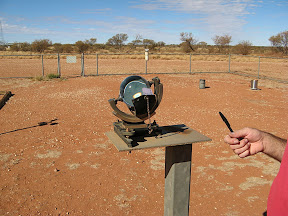
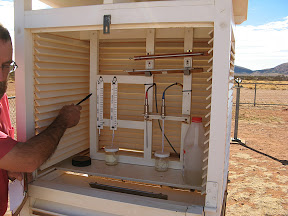
Although Giles is well inside Western Australia, it operates on Central Standard Time (Adelaide time), presumably because it was established as a branch of the Weapons Research Establishment (now DSTO) in SA in 1956 and the staff are still assigned there from the Adelaide BOM. More info on the Giles Met office can be seen here.
Giles was established in the 1950's by Len Beadell as part of the Woomera rocket range instrumentation system and much of his memorabilia still remains there, including his grader which built 6,000 kms of outback tracks and a collection of some of his original marker plaques. The originals have mostly been replaced by replicas to reduce theft and vandalism.
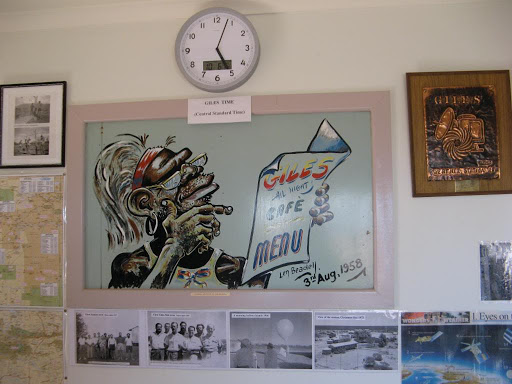



Monday 1 December 2008
Atomic Bomb Tests in the Great Victoria Desert, South Australia
In the western deserts of South Australia, 9 British atomic bomb tests were conducted during the 1950's. How Australia came to be mixed up in British atomic weapons testing program used to be on the Atomic Forum website. However that site is no longer valid so you should refer to the Wikipedia entry on the Totem bomb program. More useful information is available here.

Totem 1 Explosion. The diagonal stripes are the trails of rockets fired through the cloud to monitor radiation levels
Two bombs were detonated at Emu Field on the 15 and 27 October 1953, on the Anne Beadell Highway, 300kms west of Coober Pedy, and 7 more subsequently at Maralinga near the Trans-Australia railway.
Len Beadell built the roads and tracks to support this project, some of which are still accessible, although Maralinga access is still very restricted, and for good reason. See the findings of the Royal Commission.
You can visit the sites of the Emu Field bomb tests and it's quite an eerie experience standing on the very point where an atomic bomb was exploded. Not many people do that and survive!
The video and photo below of the Totem 1 explosion are from Department of Primary Industries and Energy. A lot more useful information can be found at Wikipedia entry on the Totem bomb program.
Totem 1 Explosion, the first atomic explosion on Australian mainland
Concrete obelisks now mark the Ground Zero points and a level of radiation still remains, but it is now at a low enough level to allow short duration visits, but not permanent habitation in the area.

Where we stood, 55 years later

The obelisk at Ground Zero
The first 2 bombs, code-named Totem 1 and Totem 11 were 9.1 and 7.1 kilotons respectively, not big by super-power standards, but they made quite a mess of the ground.
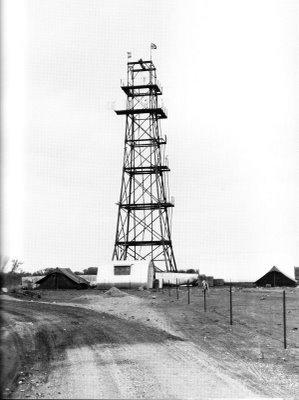
The original towers from which the bombs were suspended...
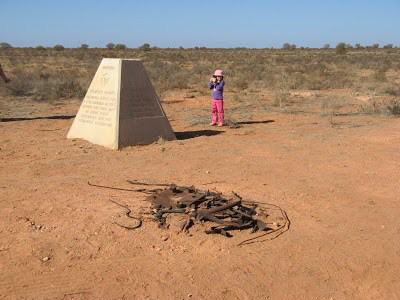
...and the remains of the towers
Of the 100ft towers they were mounted on, only a few buckled frames remain on the ground, and the surrounding desert is covered in glassy lumps of molten sand.

One of the 4 mounting pads of the 100 foot tower

Molten desert sand after the explosion
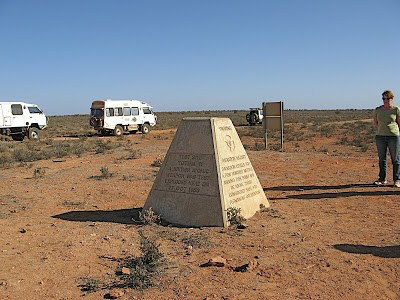
Totem 11 Obelisk, just 1 km from Totem 1

This is a display from our moving map system showing the location of the bomb sites in the Great Victoria Desert in the west of South Australia
Lake Ballard Statues
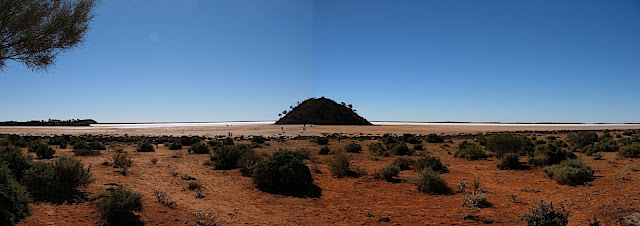
| The statues are very spaced out, and far apart! |
It comprises 51 abstract black steel figures scattered over 10 square kilometres of the lake, approximately 55km west from the town. The exhibition was commissioned from British artist, Antony Gormley, to mark the 50th anniversary celebrations of the Perth International Arts Festival in 2003. The 51 sculptures are supposedly derived from laser scans of the inhabitants of Menzies, although the likenesses are a bit difficult to comprehend.
| Yes, I can just see the likeness. |
The statues are several hundred meters apart and we only got around to about 12 of them. It's a bit tedious, sloshing around the soft surface of the lake in the hot sun, and after a while they all start looking the same.
We were not the only visitors to the salt lake, even Kangaroos apparently visit the statues. We wondered what motivated them to cross such a wide expanse of salt. Most of the statues are of women or girls, but a few are male. See what you think.










